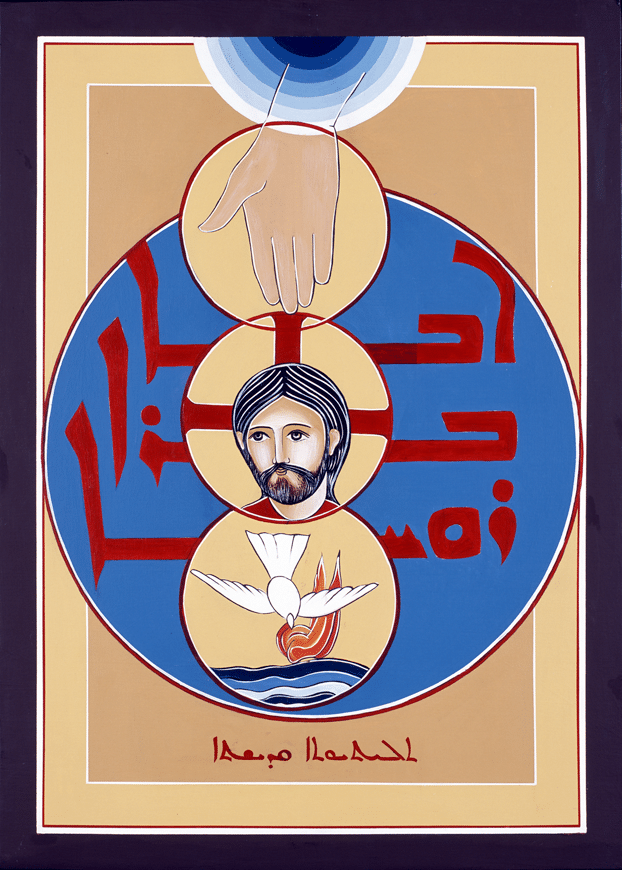
This Sunday, we celebrate Trinity Sunday in the Maronite Liturgical Calendar. This mystery is perfectly described by Paul in his Letter to the Romans (11:25-36) as “how inscrutable are his judgments and how unsearchable his ways!” As much as we discuss the Trinity, we can never comprehend this great mystery. What can be said is that the Trinity is the source, cause, purpose and end-goal of all life. Leading up to today, through our journey in the liturgical calendar, the only thing possible to understand about the Trinity is love.
It’s no coincidence that over the past few weeks the focus has been on love in the Maronite lectionary. The heart of the Trinity is love itself, a boundless, infinite and eternal heart. The Father so loved that he begot the Son to share this love with, in a complete self-giving, sharing his divinity. This love, self-giving and self-emptying is ‘agape’, one of reciprocation. Having been given all by the Father, the Son reciprocates this love perfectly to the Father. This reciprocated expression of love is shown through the procession of the Spirit from Father and Son. The Spirit, participating in the self-emptying love by the Father and Son, reciprocates, giving all that he has to the Father and Son. This is the divine dance of love, perichorisis, which is the core of the Trinity.
This is creation. The three Persons of the Trinity, sharing the same divinity, so loved that they willed to share this boundless and eternal joy with creation. In the first creation account in Genesis, we read that God created, and a wind from him also translated as spirit, swept over the face of the waters, and He spoke, “let there be light”, splitting the darkness of formless chaos that covered the Earth. God the Father, the Logos (Word) or Son and Spirit are all present. They all partake in creation, sharing their Divine Love.
This was not the end, for throughout the history of humanity, the Persons of the Trinity were made apparent. In the Old Testament (Gen 18:1-8), we read that the Lord appeared to Abraham. This is the beginning of the Trinitarian revelation of God to man, yet man did not comprehend this experience. So God became a Father for a whole nation, a chosen people, raising them, disciplining them and leading them until in the fullness of time, the Son was to be revealed. And the Word was made flesh, Christ incarnate, revealing his identity and sonship to the Father, revealing humanity’s identity as children of the Lord.
This filial relationship of Father and Son finds its perfection on the cross. In the God-forsaken silence and torment of the Cross, the Son accepts his role in redemption, the new creation, reciprocating the boundless and eternal love of the Father. The Son gives all he has, emptying himself, returning to the Father. Crying out “it is done”, the Son bows his head, loving even unto death, and gives the Spirit, fulfilling this dance of love. The side of Christ was split, and creation was renewed, the new creation had begun. Just as the first creation had given light and split the darkness of chaos that covered the Earth, this new creation allowed the Son to rise, splitting the dark torment and sorrow of death for eternity.
And now we see the beginnings of the works of the Spirit in the church, for the resurrected Son promised the Paraclete, revealed in the tongues of fire in Pentecost.
From Christmas to Lent, to Holy Week, to the glorious resurrection and now Pentecost, we see a revelation of Divine Love that has led us today to the revelation of the Trinity. Let us learn from Abraham’s hospitality, that even though we don’t understand or perceive what is before us, and we cannot understand the depth of knowledge and the mind of the Lord as Paul says, let us be willing to accept these mysterious visitors, these three Persons in our lives with a generous and open heart, not only laying out a meal for them, but setting up a dwelling place, bearing the name of the Father, Son and Spirit in us and with us.
For Christ said “go forth and make disciples of the world, baptising in the name of the Father, the Son and the Spirit”. This is a call to go forth and renew the face of the world, living the new creation every day, the creation that builds the church, living the Divine Love with the Trinity, living in the relationship of Father, Son and Spirit.
Fr Eliah Abboud is a monk of the Lebanese Maronite Order who serves at St Charbel’s Monastery and Parish in Punchbowl.
